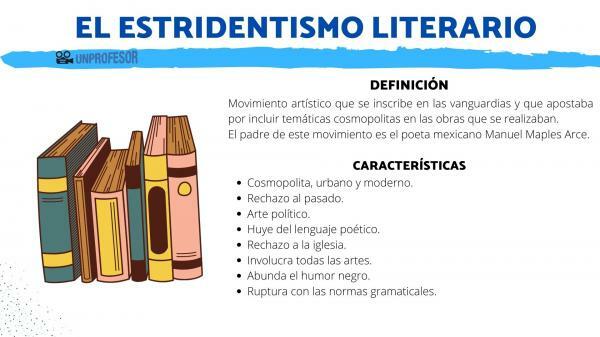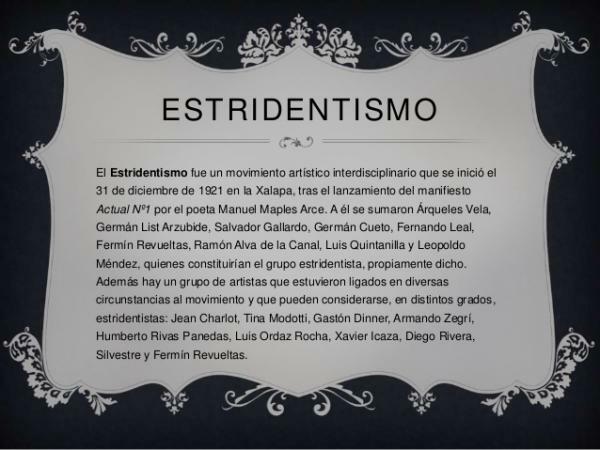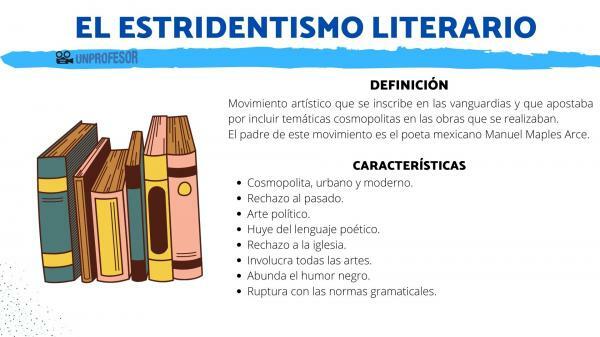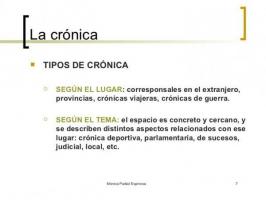What is STRIDENTISM and its most outstanding characteristics

Have you ever heard of literary stridentism? It is a movement typical of Latin American literature and is part of the vanguards; that is to say, another current that is included within the "isms" and that had its origin in Mexico from the hand of the poet Manuel Maples Arce. In this lesson from a teacher we are going to discover you what is stridentism and its characteristics highlights so that you can know in depth what this important avant-garde movement consisted of, which had a great influence in Latin America.
Index
- What is stridentism in literature?
- Characteristics of stridentism in the literature
- Stridentism: works and authors
- Stridentist poem example: Manuel Maples Arce
What is stridentism in literature?
But what is stridentism? In order to really understand what this vanguard movement it is important to pay attention to its definition.
The stridentism is an artistic movement that is part of the avant-garde and that was committed to including
cosmopolitan themes in the works that were carried out. The father of this movement is the Mexican poet Manuel Maples Arce, a writer who gave the following definition of stridentism:“It is a subversion against the reactionary principles that standardize the thinking of the intellectual youth of America.”
Maples himself was the author of the Stridentist manifesto which was published in 1921. In it, in addition to the definition of the movement, the aesthetic bases on which this current was founded were also clarified. It was a total renovation of Mexican literature and its appearance coincides with the end of the Mexican Revolution, a historical fact that defended the nationality and aesthetics of this American country.
What the Estridentistas were after was to create a new literary imaginary of the city, a new, modernized space with great importance in the fields of technological innovation and social progress. A movement that rejected the past and he focused his eyes on his contemporaneity, in fact, they even imagined a utopian city that would be the artistic version of these ideals of progress that they had in mind: Stridentópolis.
In the collection of poems Interior scaffolding of Maples we can see what the poetics of stridentism is like, with poems that talk about the city, the cosmopolitan atmosphere and the overcoming of the past.
When was stridentism born?
The beginning of estridentismo is found in the year 1921, in the city of Japala (México). It was here that the poet Manuel Maples Arce signs the first manifesto that laid the foundations of this current of the literary avant-garde. This manifesto was published in four publications in which the aesthetics of this trend and the literary and artistic principles to which the creators had to abide were exposed.
The historical context of the appearance of this current is in Mexico, a country that, after the revolution, needed to find its bases as a nation and its own identity. For this reason, the artists looked for a way to analyze their true essence, away from myths and ancient roots, and focusing on the most modern and current society.

Image: Slideshare
Characteristics of estridentismo in literature.
Now that we have known the definition of stridentism, it is important that we focus on the common elements that make the works created under this name considered as such.
There are different characteristics of stridentism that can be easily detected, and then we are going to leave you a list of the most significant:
- Cosmopolitan, urban and modern. This movement defends the artistic creation of the modern world, a world in which cities are beginning to have great importance, as well as the cosmopolitan environment. There is a tendency to worship the machine as a symbol of progress.
- Rejection of the past. As a consequence of the above, the Estridentistas rejected the past and wanted to build a new voice adapted to their times. Dive into your current reality to be able to give it an artistic form. With this, there is also a rejection of all the heroes and myths of the past, since they impede the evolution and progress of society (according to this current).
- Political art. Another characteristic of Estridentismo is that it was a movement closely linked to politics. They considered that art and life are intrinsically united and, therefore, poets have to have a social commitment to progress and advancement. Some of the members of this movement ideologically positioned themselves on the side of "socialist realism."
- Run away from poetic language. The Estridentistas bet on using "antipoetic" methods, that is, they did not use an aesthetically careful, melodious language. nor worked, but included the terminology typical of modernity, such as abbreviations, numbers, foreign words, etc. A reflection of the reality of the cities and, therefore, of the world they wanted to show.
- I reject the church. The church represented the past for the Estridentistas and therefore something they had to overcome. The need for education for the whole of society, for improvements in working conditions and for overcoming the challenges, was defended. ancient molds that impeded the evolution of citizens (such as, for example, the church, which had a lot of power in Mexico).
- It involves all the arts. Another of the characteristics of Estridentismo is that it was a current that, not only occurred in the field literary, but affected all artistic disciplines: from painting, to sculpture, photography, etc.
- Black humor abounds. Within the literature of estridentismo, it should be noted that the tone most used by poets was black humor. A resource with which they mocked the scourges of the past and criticized society to show the path that should be followed.
- Break with the rules. Also, if we talk about literary stridentism, we must point out that the poets wanted to overcome all the influence with respect to the past and, therefore, they skipped grammar rules, played with the meanings of words, etc. The aim was to free language also from the oppression of conventions and tradition.

Stridentism: works and authors.
We conclude this review of this movement in Latin American literature to focus, now, on the works of stridentism and their authors. We have reviewed the most prominent names that left their mark in the history of art and literature so that you can get to know them better.
Manuel Maples Arce (1900-1988)
He is the father of estridentismo and, therefore, the most prominent name of this avant-garde current. As we have already indicated, this Mexican poet was the author of the manifesto and the one who stipulated the bases and the aesthetics that should be followed. Among his most outstanding works are:
- Interior scaffolding
- Urbe (Bolshevik super poem in 5 songs)
- Interdicted poems
Germán List Arzubide (1898-1998)
This is another of the most prominent authors of Estridentismo. Also of Mexican origin, this poet and journalist fought during the Mexican Revolution on the side of Carranza. Within his literary works, we find.
- Plebs
- Corner
Arqueles Vela Salvatierra (1899-1977)
The authors mentioned above cultivated stridentist poetry; However, Vela Salvatierra is the first author who opted to create a narrative text related to this movement. But, in addition, he also signed a large number of well-known poems. His most outstanding works are:
- Miss Etcetera (Stridentist narrative)
- The gray path and other useless poems
- Nobody's Coffee (set of stridentist stories)
Salvador Gallardo Dávalos (1893-1981)
We end this review of the Estridentista works and their authors to talk about Gallardo, a writer and member of Mexican politics who, in fact, also wrote the third manifesto. In addition to this, some of the best valued works of him are:
- Hiker guide
- The garden of temptations
- The electric pentagram

Image: Universal Literature
Stridentist poem example: Manuel Maples Arce.
To finish, we leave you with an example of a stridentism poem written by the father of the current: Manuel Maples Arce.
Route
Aboard the express
We fly over the unreality of the continent.
The evening off in the mirrors,
and goodbyes bleed in my mind.
The nostalgic heart senses
throughout this journey,
vagrant literatures
that shook the feathers
of its wings,
in the cold corridors of the landscape.
The sleepwalking countryside goes by
as the train moves away between the tunnels of sleep.
There from time to time
cities
stoned with screams and goodbyes.
Poppy rivers
that come from the bottom of the years,
they go on endlessly,
under the bridges,
that they affirmed
its metallic jump
on the slopes.
Then mountains, silent armies
they howl to death.
Between the cracks of the night
I am tormented by the insomnia of a star.
Trains that always march until the absence,
one day,
without knowing it,
we will cross
in geography.
If you want to read more articles similar to What is stridentism and its characteristics, we recommend that you enter our category of History of Literature.
Bibliography
- Mora, F. J. (2000). Mexican stridentism: signs of an aesthetic and political revolution. In Annals of Hispanic American Literature (Vol. 29, pp. 257-275).
- Niemeyer, K. (1999). Art-life: Round trip? The case of estridentismo. The new man being born... Merge literature, arts and life as a practice of the avant-garde in the Iberian World.
- Jitrik, N. (2011). Stridentism and the work of Manuel Maples Arce. Mexican Literature, 4 (1), 27-63.
- Stephan, B. G. (2001). The narrative of estridentismo: El Café de Nadie by Arqueles Vela (pp. 207-224). Vervuert Verlagsgesellschaft.



